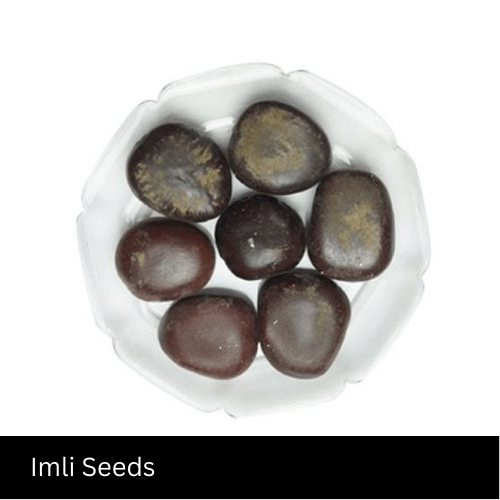About Imli / Tamarind
The fruit is usually sold in pods, which contain a sticky pulp that surrounds several seeds. The pulp has a sour and tangy flavor, and is often used as a souring agent in dishes. It can also be made into a paste or concentrate, which is commonly used in Indian and Southeast Asian cuisines.
In addition to its culinary uses, tamarind has also been used in traditional medicine for its potential health benefits. It is high in antioxidants and has anti-inflammatory properties, which may help protect against certain diseases and conditions.
Overall, imli/tamarind is a versatile ingredient with a unique flavor and potential health benefits, making it a popular choice in many different types of cuisine.
- Hindi: Imli, Amlika
- Tamil: Puli, Puli Maram
- Telugu: Chintapandu
- Malayalam: Puli, Valanpuli
- Kannada: Hunase, Hunase Hannu
- Bengali: Tetul, Tetuler Chatni
- Gujarati: Ambli, Amli
- Marathi: Chinch, Chinch Gola
- Punjabi: Imli, Imli Wali Chutney
- Arabic: Tamr Hindi
- Spanish: Tamarindo
- Thai: Ma-kham-pon
- Indonesian: Asam Jawa
- Vietnamese: Me
These are just a few examples of the many names that imli/tamarind is known by in different regions around the world.
-
High in antioxidants: Imli/tamarind is rich in antioxidants such as polyphenols and flavonoids, which help protect against oxidative damage caused by free radicals.
-
Anti-inflammatory properties: Imli/tamarind contains anti-inflammatory compounds that may help reduce inflammation and associated health issues.
-
Lowers cholesterol levels: Some studies suggest that imli/tamarind may help lower total cholesterol, LDL cholesterol, and triglycerides.
-
Controls blood sugar levels: Imli/tamarind may help regulate blood sugar levels, making it a potential treatment option for people with diabetes.
-
Promotes digestive health: Imli/tamarind contains fiber, which helps promote digestive health and prevent constipation.
-
Boosts immune system: Imli/tamarind is rich in vitamin C, which is essential for immune system function and may help protect against infections.
-
May reduce the risk of cancer: Imli/tamarind contains compounds such as polyphenols, which have been shown to have anti-cancer properties.
-
May improve heart health: Imli/tamarind may help improve heart health by lowering blood pressure and reducing inflammation.
-
May help with weight loss: Imli/tamarind may help with weight loss by promoting satiety and reducing calorie intake.
-
May improve skin health: Imli/tamarind contains compounds that may help improve skin health and reduce the signs of aging.
These potential benefits of imli/tamarind are supported by scientific research, but further studies are needed to confirm these findings and determine the optimal doses and forms of imli/tamarind for each health benefit.
-
Sweet tamarind: This type of tamarind has a sweeter taste and is often used in desserts and sweet dishes.
-
Sour tamarind: This type of tamarind has a sour and tangy taste and is often used as a souring agent in savory dishes.
-
Seedless tamarind: This type of tamarind has been processed to remove the seeds, making it easier to use in cooking.
-
Tamarind paste: Tamarind paste is made from the pulp of the tamarind fruit and is often used as a flavoring in sauces, chutneys, and marinades.
-
Tamarind concentrate: Tamarind concentrate is a more concentrated form of tamarind paste and is often used in larger quantities in cooking.
-
Tamarind candy: Tamarind candy is a popular snack in some parts of the world, made from sweetened tamarind pulp.
The type of imli/tamarind you use will depend on the recipe and the desired flavor profile. For example, sweet tamarind is often used in desserts and drinks, while sour tamarind is a common ingredient in savory dishes such as curries and chutneys. Tamarind paste and concentrate are also commonly used in sauces and marinades.
- Hindi: Imli
- Tamil: Puli
- Telugu: Chintapandu
- Malayalam: Puli, Valanpuli
- Kannada: Hunase, Hunase Hannu
- Bengali: Tetul
- Gujarati: Ambli, Amli
- Marathi: Chinch
- Punjabi: Imli
- Arabic: Tamr Hindi
- Spanish: Tamarindo
- Thai: Ma-kham-pon
- Indonesian: Asam Jawa
- Vietnamese: Me
These are just a few examples of the many names for imli/tamarind in different regions around the world.
-
Tartaric acid: This organic acid gives imli/tamarind its tangy and acidic taste.
-
Flavonoids: These antioxidants are found in the seed coat and pulp of the imli/tamarind fruit and have been shown to have potential health benefits.
-
Polyphenols: These compounds are also found in imli/tamarind and have been associated with several health benefits, including anti-inflammatory and anti-cancer properties.
-
Carotenoids: These pigments are responsible for the reddish-brown color of the imli/tamarind fruit and have antioxidant properties.
-
Vitamin C: Imli/tamarind is rich in vitamin C, which is essential for immune system function and has antioxidant properties.
-
B vitamins: Imli/tamarind also contains several B vitamins, including thiamin, riboflavin, and niacin.
-
Minerals: Imli/tamarind is a good source of several minerals, including potassium, calcium, magnesium, and phosphorus.
These chemicals are just a few examples of the many compounds found in imli/tamarind that contribute to its potential health benefits and culinary uses.

